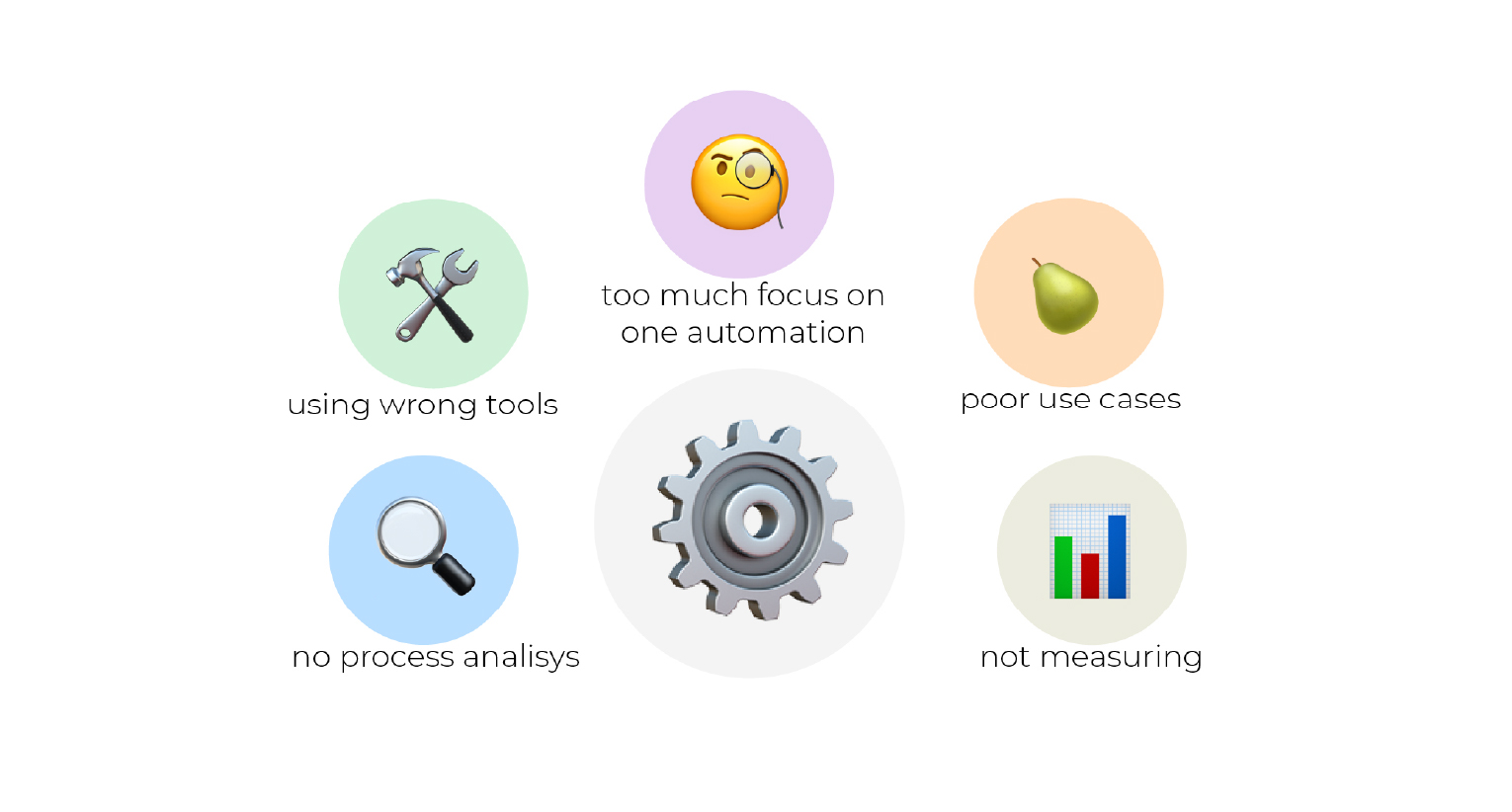
Backoffice automation - 5 things to avoid
Nov 10, 2021 8:46:26 AM
Backoffice automation has the potential to improve efficiency, accuracy, performance and lower costs, so it is no surprise that many businesses are choosing to implement automated processes across their back-office departments. Although there are many brilliant benefits, process automation can be a steep learning curve, and automation mistakes can easily be made which jeopardise the success of automation projects.
With so many businesses under pressure to find more efficient ways of working, taking the leap into an automation project can be daunting, especially when you need to compare potential technologies, vendors and internal automation candidates. However, our team are here to help, and over the years we have helped many businesses resolve their automation failures. From our experience, there are some clear areas where we commonly see automation mistakes and we hope this blog will help you to avoid these pitfalls with your own Microsoft automation project.
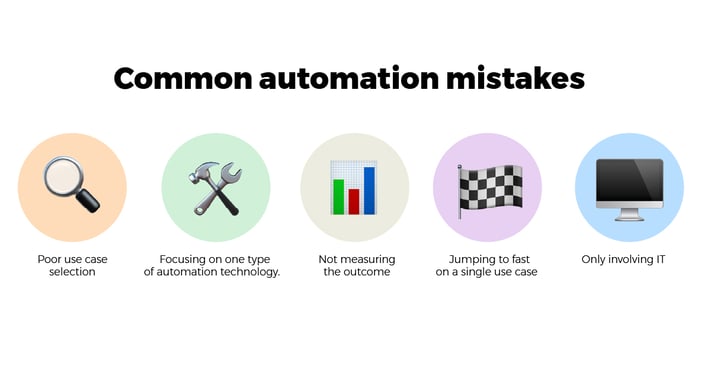
1. Not focusing on low hanging fruit
It is important to do your research, so that you can establish which areas of the business will benefit the most from automation. There is a tendency with some businesses to focus on very simple and quick to automate processes, which are implemented for the sake of automating. However, they may have very little benefit to the actual back-office efficiency. In comparison, some businesses will dive into the deep end and attempt to automate very complex cases, which can be difficult to implement.
When you are taking the first steps into back-office automation it is important not to begin with a project which is either too complex or so simple that it is of very little benefit. Ideally, you will be looking to start with simple, quick and low-cost automations, which have the most impact on your business, in other words, the low hanging fruit.
Although the most complex projects which span multiple departments and involve many teams are likely to be of the greatest benefit to your business, they will be complex and it will take much longer to design and implement the automation. Instead, start by focusing on tasks which will have a quick impact on the day-to-day activities of the team, and involve these individuals at the planning stage to ensure a successful and effective outcome.
The best approach is to follow our 3-step process:
- Brainstorm potential automation options based on the points outlined in figure 2 below.
- Estimate the time/cost saving potential
- Use relative targeting to find the best options – For more information refer to our ‘Relative targeting for back-office automation’ guide.
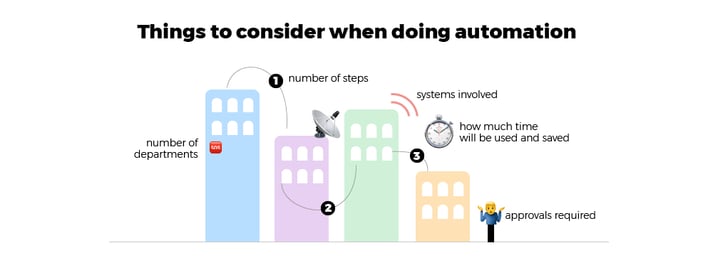 2. Focusing on one type of automation technology
2. Focusing on one type of automation technology
Software that is capable of automating time-consuming and costly processes is the type of technology that every business owner and manager dreams about, however, it is important to choose the right tools for each specific task. Don’t waste your time and money on a single tool that does not fit your exact business requirements, simply because you are in a rush to get started with automation.
Instead, take the time to understand the exact requirements of your back office and pinpoint which type of technology is the best fit. There will be no single Microsoft automation tool that is capable of managing every type of automation you need, so you will need to carefully pick the best options. For example, RPA is a great tool when automating Legacy apps, with Power Automate and Logic Apps providing simple and robust capabilities when used with modern apps.
In addition to considering the capabilities of software such as Microsoft tools, you also need to consider the capabilities and experience of those who will be using the software. For example, perhaps your IT team will be more comfortable with Azure Automation software for some processes? Whereas, a Backoffice admin team may require a simple tool that requires minimal input.
It is also important to consider how the automation tools you choose will interact with the other platforms which your team are already using. By analysing your Backoffice technology at the beginning of the process, you will be able to choose automation software that easily interacts with existing systems. For example, will your automation software integrate directly or will you need to use a platform such as Microsoft Power Automate?
The end goal should be to quickly automate every potential process so that the business can improve productivity and lower costs, and the only way to achieve this is to use multiple tools.
3. Not measuring outcome
There is no point investing time and money in an automation project if you are not going to measure the outcome and the return on your investment. Although the financial return can be difficult to quantify, the team need to feel that they have more spare time to focus on other areas and accuracy and efficiency overall should have improved.
By measuring the outcome of automations, the door will be open for your business to explore new automation opportunities or to adopt a different approach to ensure a successful outcome with the project. Our advice is to consider the following areas when planning and reviewing your back office automation:
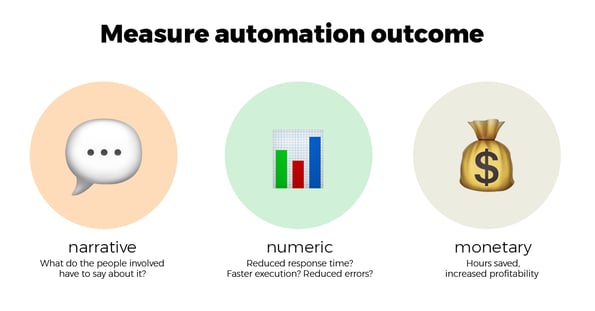
- Narrative – Discuss the impact of the automation with your team and customers, are they noticing improved quality, speed and accuracy? Ideally, your team should be reporting that efficiency has improved and that the system is fully embraced.
- Numeric – In addition to considering the opinions of your team, do the figures support their feedback? For example, have customer response times reduced and are execution times faster? We also recommend calculating whether the failure rate of processes has improved, as a high failure rate will indicate potential weaknesses, such as bottlenecks within the system. Whereas, a low failure rate will indicate that automation has successfully improved productivity. You may find that what you thought was an excellent automation opportunity has actually increased the failure rate once implemented.
- Monetary – The most important factor with most automation projects is often to improve efficiency so that costs can be reduced. To calculate the monetary impact of an automation project, you need to consider factors such as the hours saved, the ongoing cost of the software and whether profits have actually increased.
Once you know the outcome of a Backoffice automation project, you will be able to identify areas to improve within the setup of the tool, or you may even find that the project was a complete success and is running smoothly. In many situations, the first automation use case may not provide a monetary benefit, however as the organisation begins to embrace new ways of working and the software is incorporated into other areas, the increased efficiency quickly leads to monetary, numeric and narrative benefits.
 4. Jumping too fast on a use case
4. Jumping too fast on a use case
You may quickly identify a variety of potential use cases, from sending simple email reminders through to managing complex expense reclaim processes, however, you should never jump in too quickly. Once you have identified an automation opportunity, do not start designing the solution until the entire scope of the project is completely clear. If you do not have a clear goal and strategy in place, you may end up investing time, money and energy into automated processes that do not improve your Backoffice functions.
A poorly planned and implemented automation could end up offering no real return on investment, so it is important to build an automation that balances effort and impact, as you can see below.
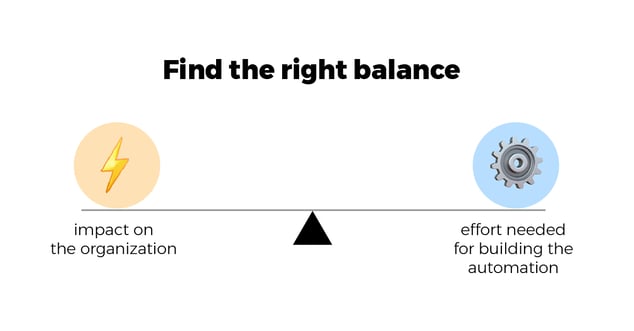
In practice, finding the best use cases is not always a simple and straightforward process, however our ‘Backoffice – a guide to select automation use cases’ will explain the process of evaluating the impact on the organisation and whether a task is really worth automating.
5. Only involving IT
Making a successful change to core Backoffice operations will require everyone to be on board. It is very common for business to utilise the skills of their IT team when creating automations, however if other employees are not involved at the outset, this can create problems. It is important that those who will actually be using the new automation tools benefit, and by involving these team members in the design of the automation it will help to ensure that the software is successfully adopted.
The Backoffice is often managed by departments such as finance, business operations, HR, marketing and order processing, with every department playing a key role in identifying and planning successful use cases. Without the full team’s input, you will be at risk of not catching the most valuable automation cases, which will result in money and time wasted.
There are two critical phases which the whole team should be involved with, the testing and implementation of the system and the ongoing training and adaptation of the automations. It is important to create a communication culture, where the whole team is able to be involved in the design and development of systems. This culture of automation will lead to constant improvements to processes throughout the entire business.
Don’t make these automation mistakes and get started with your successful automation project today!
Business automation provides clear benefits to businesses that are looking to lower costs and improve performance and effectiveness, however, careful planning and implementation is essential. Your business will only reap the benefits of Backoffice automation if the tools are properly implemented and managed, otherwise, your efficiency dreams could soon spiral.
Don’t let the automation mistakes listed above ruin your chance of benefitting from automation, and contact our experienced team today. We will advise, organise, plan and implement the best automation solutions so that you quickly feel the benefits of streamlined back-office automations. For more advice or to book a free 1-hour Automation Consultation with the Nudge IT experts, complete this form and we will be in touch very soon.
Submit a comment